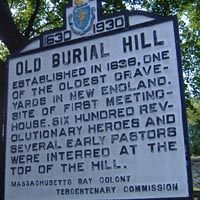WWF, a lesson in pseudo-history, and some real history

A couple of things that came up at Walking With Fire ought to be noted.
We went to America's Stonehenge (biggest fraud ever!) one day, and there was a large map on the wall about all the "explorers" who have been sent around the world. A couple caught our eye: Prince Madoc, a Welshman who discovered America in 1170 and settled in Kentucky; and Sir Henry Sinclair, a Templar Knight who discovered Nova Scotia in 1397.
All we had when looking at the maps were the names, so I wrote them down in hopes of eventually figuring out who they were. And wouldn't you know it, the Internet has come through again.
Also, we came across a memorial to Captain James Mugford in Marblehead, who was killed on May 17, 1776. His grave was at the top of Old Burial Hill, on a monument that describes his ship, the Franklin (60 tons and four 4-pound guns), and the capture of the HMS Hope, a 300 ton, 10 gun ship. The Hope was one of the most valuable prizes of the revolution, amounting to about $1,349,343.15 in prize money.
Captain Mugford had been pressed into service on a British frigate, where he learned of the Hope's arrival and destination. His wife managed to get him released from his impressment by indicating that they were only recently married and that she needed the support. He immediately boarded a fishing ship called the Franklin, outfitted the ship for battle, and got his own crew (he had not received an actual commission at this point, only applied for it, which makes him technically a pirate, and the prize money was never properly paid out).
When the Hope appeared, he sailed alongside her, still pretending to be a fishing boat. He then grappled the English ship, called his crew from below decks, and boarded her. Then he sailed off to Boston with her.
All this was done within sight of the British fleet anchroed at Nantasket Roads.
The siezure of the powder on the Hope also prevented the British, at Nantasket Roads, from opposing Washington's entry to Boston in March 1776 (the British had evacuated, and were partially pending the supply of powder from the ship to counterattack). Washington also had only nine rounds of powder to each man at this point, and could never have repelled the British, had they attacked.
Two days after the siezure, the Franklin was sailing through Sherley Gut alongside the USS Lady Washington and was attacked by a number of British ships (about 100 or so men in 12 or 13 ships, compared to the 21 men on the Franklin and 7 men on the Lady Washington). Mugford was mortally wounded, the only loss of life on the American side, his last words being an answer to the question, "Are you wounded?"
"Yes, but don’t let the enemy know the situation, and if I die act as if I were alive and am still commanding."
The Franklin escaped, and Mugford was buried with full military honours on Old Burial Hill.
A good description can be found about half-way down this page, utilizing primary sources to describe the battle in which Mugford lost his life (search on "May 17" to find the specific spot). Apparently, before he died, Mugford personally cut off the hands of about 5 pirates trying to board.
A couple of sources.